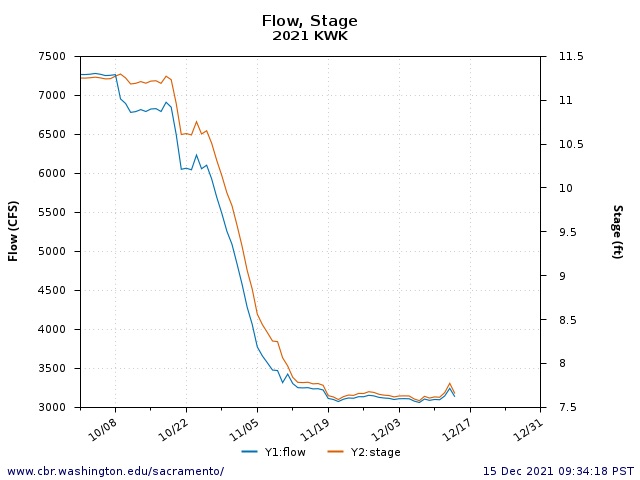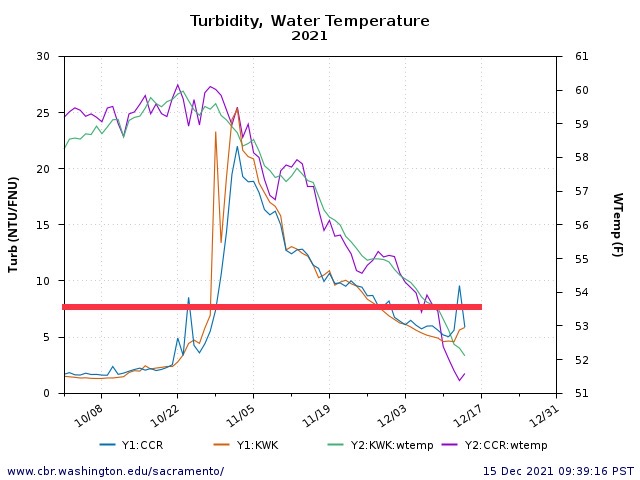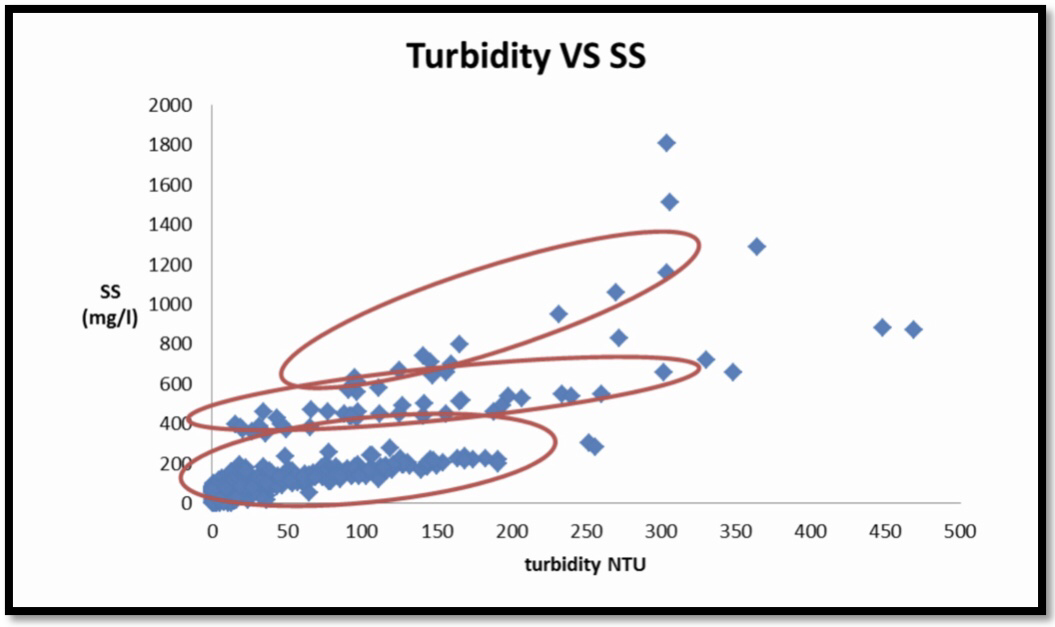Flow pulses released from Shasta Reservoir are badly needed in fall to match up with downstream tributary flow events. Such flow pulses are needed to support the emigration of young winter-run salmon from the spawning reach near Redding. The Redding reach receives no flow pulses because fall-precipitation inflows to Shasta are retained as storage in the reservoir, even in wet years. In a December 2018 post, I described the lack of these badly needed and widely recommended fall flow pulses.
The problem occurred in fall 2021. Because water year 2021 was a critically dry year with near record low end-of-September Shasta storage, there was understandably a common interest in retaining inflows to the reservoir. But since water year 2022 began on October 1, there were major Valley-wide storm events, including significant inputs into Shasta Reservoir (Figure 1).
Despite these inflows, there were only reduced releases from Shasta this fall as irrigation demands and water transfers ebbed (Figure 2). When the flow rates in the Redding reach dropped, water levels also fell 3 to 4 feet, reducing available rearing habitat as well as flows that might stimulate emigration. The minimal Shasta-Keswick flow releases were high in turbidity (Figure 4), due to the storm-caused erosion in the severely storage-depleted reservoir. The stage drop and higher turbidity also hurt the fall-run spawners during the peak of their fall spawning in the river near Redding. None of Mother Nature’s late October flow gift to Shasta Reservoir was shared with beneficial uses immediately downstream.
Further downstream, the Sacramento River received its own gifts (Figure 4), but only from downstream (20-60 miles) tributary inputs. The young winter-run salmon in the Redding spawning reach should have been given a boost to get them to where they could have benefitted from tributary inputs to the main lower river. Higher flows in the mainstem provide quicker and safer trips to the Delta, Bay, and ocean.
It is apparent that many of the young salmon left the spawning reach earlier, during the higher September-October flows (Figure 5). Many of these fish spent the early fall rearing in the upper 60 miles of river in less-than-optimal water temperatures, greater than 58ºF (Figure 6). This is another reason a flow pulse to stimulate the emigration of those juvenile salmon that remained in the uppermost and coolest reach near Redding was important.
The reason that flow rate is important is that it speeds young salmon emigration. How fast they move to the Bay-Delta greatly influences their survival (Figure 7). In low-flow drought years like water year 2014, the fall emigration takes longer (Figure 8). Tag data also indicate flows near 10,000 cfs improve survival over lower fall flows (Figure 9).
So what should the prescription for the fall of 2021 have been? First, Shasta Reservoir should not have been drawn down so far as to provide release of only warm muddy water. Second, a pulse flow of at least 7000 cfs was needed coincident with the first lower river flow-pulse event with the reservoir release sometime between October 23 and November 1. This would have added 2000 cfs to the already existing 5000 cfs reservoir releases (see Figure 2), and 2000 cfs to the already existing 8000 cfs Red Bluff flow (see Bend flow in Figure 4). Third, a second flow pulse of about 5000 cfs Keswick release was needed on or about December 13 coincident with the second precipitation event and Red Bluff pulse. This would have added 2000 cfs to the already existing 3000 cfs reservoir release. Such one-day pulse releases should be short enough in duration to make them unlikely to stimulate substantial spawning of fall-run salmon in areas where the eggs would be subject to stranding.
In conclusion, the two days with an added release of 2000 cfs to create two separate pulse flows would have amounted to 8000 acre-feet of Shasta or Whiskeytown/Keswick storage. Whiskeytown held 200,000 acre-feet of storage of cooler, lower turbidity Lewiston Reservoir/Trinity River water that could have provided the 8000 acre-feet needed for the Keswick flow pulses. These two flow pulses would have provided significant benefit in improving the survival of emigrating young winter-run salmon in the Sacramento River near Redding. A December pulse would also have created benefits for the fall-run spawn.
A one-day flow pulse with an added release from Keswick of 2000 cfs in early January would still provide benefits for outmigrating fall-run salmon.

Figure 1. Four significant precipitation events produced 5000 to 13,000 cfs daily inflow to Shasta Reservoir in fall 2021.

Figure 2. Flow and stage in the Sacramento River below Keswick Dam near Redding in fall 2021.

Figure 3. Water temperature and turbidity in the Sacramento River below Keswick Dam (KWK, RM 300) and above mouth of Clear Creek (CCR, RM 290) near Redding in fall 2021. Red line is 7 NTU turbidity above which eggs and embryo salmon in spawning redds are adversely affected.

Figure 4. Daily flow average (cfs) of Sacramento River below Keswick Dam (KWK, RM 300), at Bend Bridge (BND, RM 240), and at Wilkins Slough (WLK, RM 140) in fall 2021.

Figure 5. Passage rate of juvenile winter run salmon at Red Bluff screw traps and nearby Bend Bridge gage flow summer-fall 2021. Note increased catch rate during pulse flow events.

Figure 6. Water temperature (F) in the Sacramento River below Keswick Dam (KWK, RM 300) and at Red Bluff (RDB, RM 240) in fall 2021.

Figure 7. Estimated survival rate from Redding to Delta for juvenile salmon per the number of days spent upstream. Source: NMFS presentation.

Figure 8. Cumulative passage of winter-run at Red Bluff screw traps 2007-2013. Note longer period of passage in fall 2013 for Brood Year 2013. Source: USFWS Red Bluff.

Figure 9. Survival of juvenile salmon (acoustic-tagged wild and hatchery spring-run and fall-run salmon) as a function of flow in upper Sacramento River from Red Bluff (RM 240) to the Delta (RM 100). NMFS, Santa Cruz: “Nonlinear survival of imperiled fish informs managed flows in a highly modified river”. Cyril J. Michel $, Jeremy J. Notch, Flora Cordoleani, Arnold J. Ammann, Eric M. Danne. First published: 19 May 2021 doi.org/10.1002/ecs2.3498. Ecosphere / Volume 12, Issue 5 / e03498













